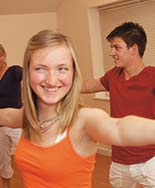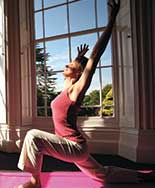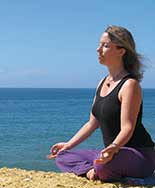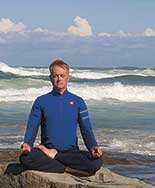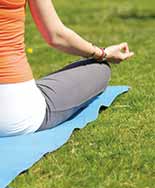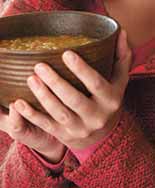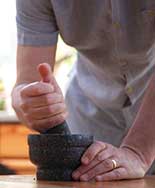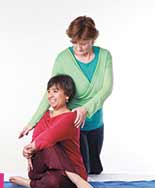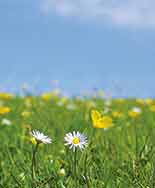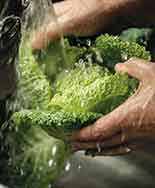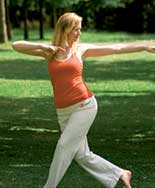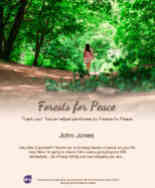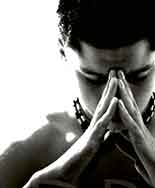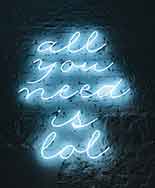
The HEART centre. This is number 4 of the 7 main energy centres and plays a very important role in transforming energy from the lower centres (which have to do with the way we treat ourselves and those around us), up to our higher centres (which eventually connect us to the Universe or the spiritual realm or however we perceive it). The chakras gradually rise from the gross to the more subtle... as such, anahata or the heart chakra, is an enormously important centre to work with.
For those who have an awareness of colours, the heart centre is an exquisite translucent green, rather like a magnificent shining emerald or a canopy of leaves in early summer with the sunlight shining through them.
During the course of our lives it really is highly unlikely that our heart centre will remain totally in balance, and so to help us through the difficult times let us consider how we might be feeling if anahata is out of balance.
- • actual heart problems (a whole range)
- • respiratory ailments
- • upper back pain
- • tight shoulders
- • selfish/mean spirited
- • unforgiving
- • resentful, holding a grudge
- • jealous
- • unloved
- • distrustful
- • lack of self-care or self-love
- • devastating grief
Whenever we experience personal losses, betrayals, and other emotional traumas we tend to protect ourselves from further pain by closing down our hearts. How can we help to sort this out and truly open up our heart centres once again?
For me personally, a regular practice of Dru yoga has been essential in my life... nearly 30 years ago now my heart was well and truly broken and as I struggled through the next few years bringing up two very small children on my own whilst working full time in an extremely stressful job I developed arrhythmia, an irregular heartbeat. I started taking medication and then I had my first encounter with Dru yoga, attending a class once a week and soon I became completely hooked! After approximately two months I came off the medication and my heartbeat was absolutely fine... the healing power of Dru. This is just one of the reasons why I am so passionate to share these essential heart opening practices in classes, on courses and in this blog.
Since the heart chakra is associated with the element of AIR my first recommendation is (you’ve guessed it!) to get out in the fresh air and breathe, if possible in nature where the air is charged with life force and the beauty around us begins to melt our hearts. You will know the other things that melt your heart, for me there are loads of things, flowers, sunsets, babies, puppies, kittens, the list is endless…
There are so many fantastic Dru sequences that activate the heart centre (actually all of them!) but some of my very favourites are EBR 2, EBR 3, EBR 4, EBR 10 and the Seat of Compassion sequence. Here is a link to one of my dear teachers taking you through EBR 3, https://youtu.be/NC0XchZvDYY.
A very powerful element of these sequences is the anahata breath:
stand in tadasana, extend your arms in front of you with elbows softly bent and palms facing towards the centre of your chest. Draw the palms towards you as you breathe in and then turn the hands and gently push them away on the outbreath at the same time gently softening your knees. Continue with these simple but very potent movements (coordinated with the breath) eventually closing your eyes or softening your gaze. As you draw your awareness in, you may use this visualisation, for example.. draw in love to your heart and then extend compassion out as you breath out.
Other breath work or pranayama which works very strongly on the heart includes bramhari breath, sometimes called the humming bee breath. In its simplest form we breathe in through the nose and then on the outbreath hum for as long as is comfortable. Repeat 3 or 4 times and then sit quietly taking your focus to your heart…
There are numerous very effective postures, for example the chair of the heart, the cowface, the cobra, the camel, the eagle and the fish. Here is a useful link to a full description of why and how to practise the chair of the heart: https://druonline.wordpress.com/tag/chair-of-the-heart/
I highly recommend a book called ‘The Dance Between Joy and Pain’, a Dru publication which has loads more practices specifically designed to activate and balance anahata. https://druyoga.com/uk/shop/the-dance-between-joy-and-pain-revised-and-e...
One of the most accessible practices which we can practice every morning, every evening... in fact any time of day or night is that of gratitude. Simply make a list of some of the things you are truly thankful for. Really, really amplify that sense of gratitude within you and notice how that feels. You can write a list or just think about it, even better you can do a simple meditation on gratitude:
Sit comfortably with an upright spine
focus on your breath for a few moments and notice how the sternum rises and falls with the breath,
taking your awareness into the centre of your chest
Now begin to mentally list things that you are grateful for: material essentials (a roof over your head, clothes, food etc)… your source of income…your body and your health… the beauty of the natural world... your friends and neighbours… your family… let the gratitude deepen...
notice how you feel: a sense of warmth, a sense of softness, a sense of joy and deep love
Sit in this space for as long as you like.
When you are ready, notice the rise and fall of your sternum once more, notice your breath, your arms and legs and slowly prepare to open your eyes with a beautiful smile on your face and then consciously offer out that love and compassion to a person or group of people in need of it at this moment.
The final practice I will mention is that of kindness. Being kind to others even in really small ways, a sincere smile or compliment, a gesture, or something bigger helps us to develop our capacity for compassion, for love and joy. And we don’t need to restrict kindness just to people we know! ...let’s not forget the birds and the animals we meet.
An extremely powerful practice is to extend compassion and kindness to people we don’t know. Random acts of kindness where we receive no thanks for what we have done are just amazing!
Let us never forget the importance of extending kindness to ourselves practising self care. However that will be the subject of a future blog, watch this space!
When anahata is truly activated this is a truly blessed state, where we are filled with love, compassion and joy.
Anahata actually translates as ‘unstruck’, what on earth could that mean?? ...
Some say it is the sound of an unstruck bell within the heart which we can only hear when we access this centre very deeply. Could it possibly refer to that whisper which comes from our heart to guide us and help us? Or is it indeed something even more subtle than that?
OM NAMOH BAGHAVATE VASUDEVAYA


